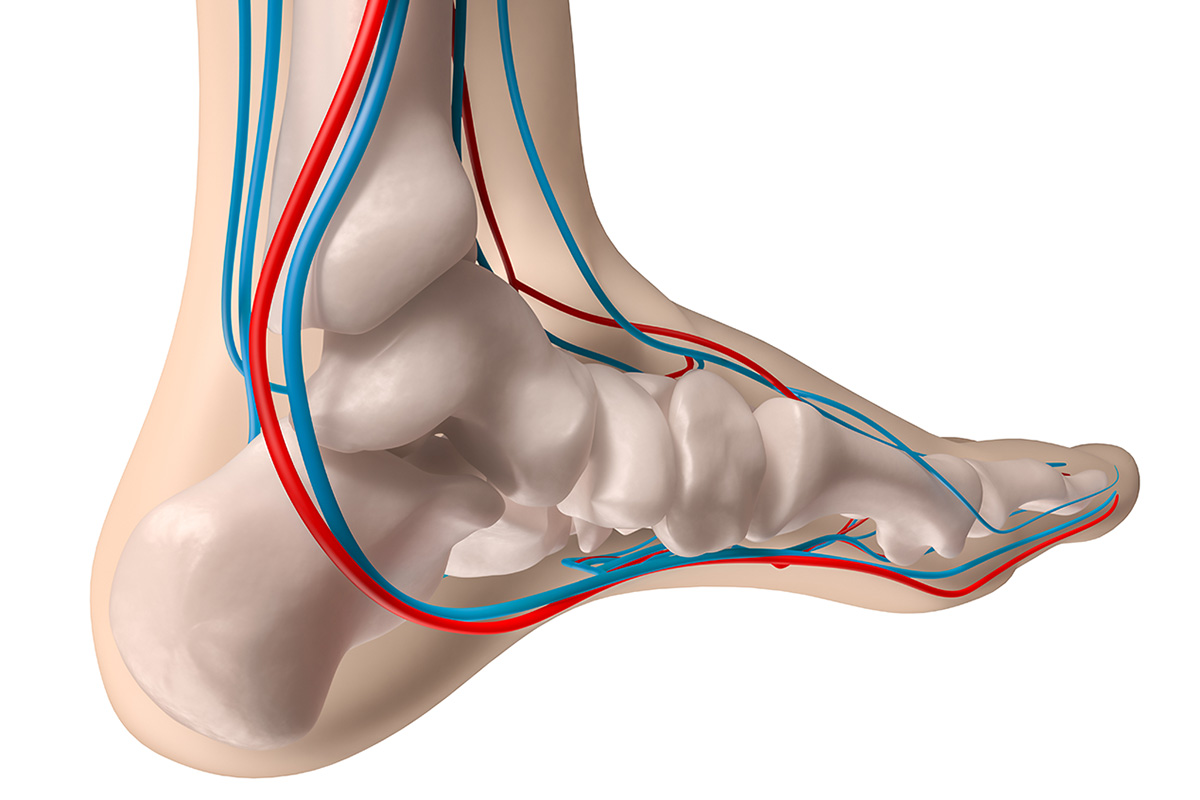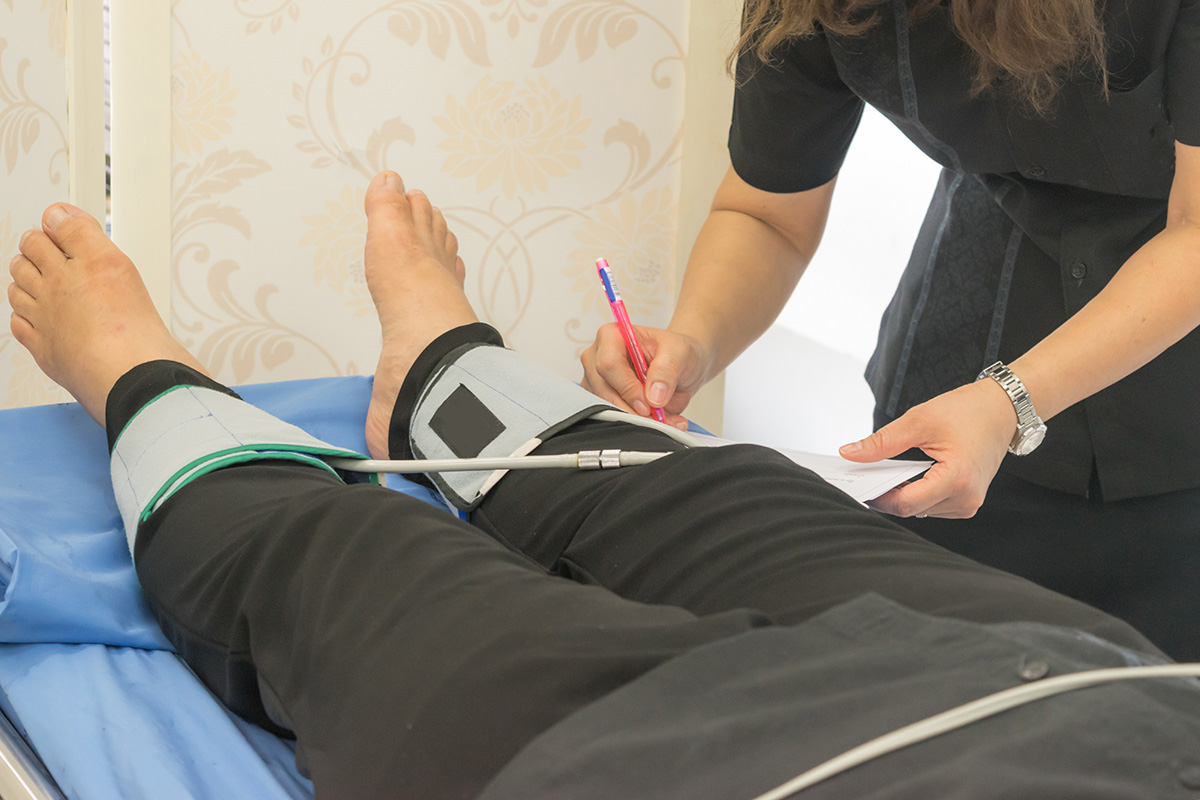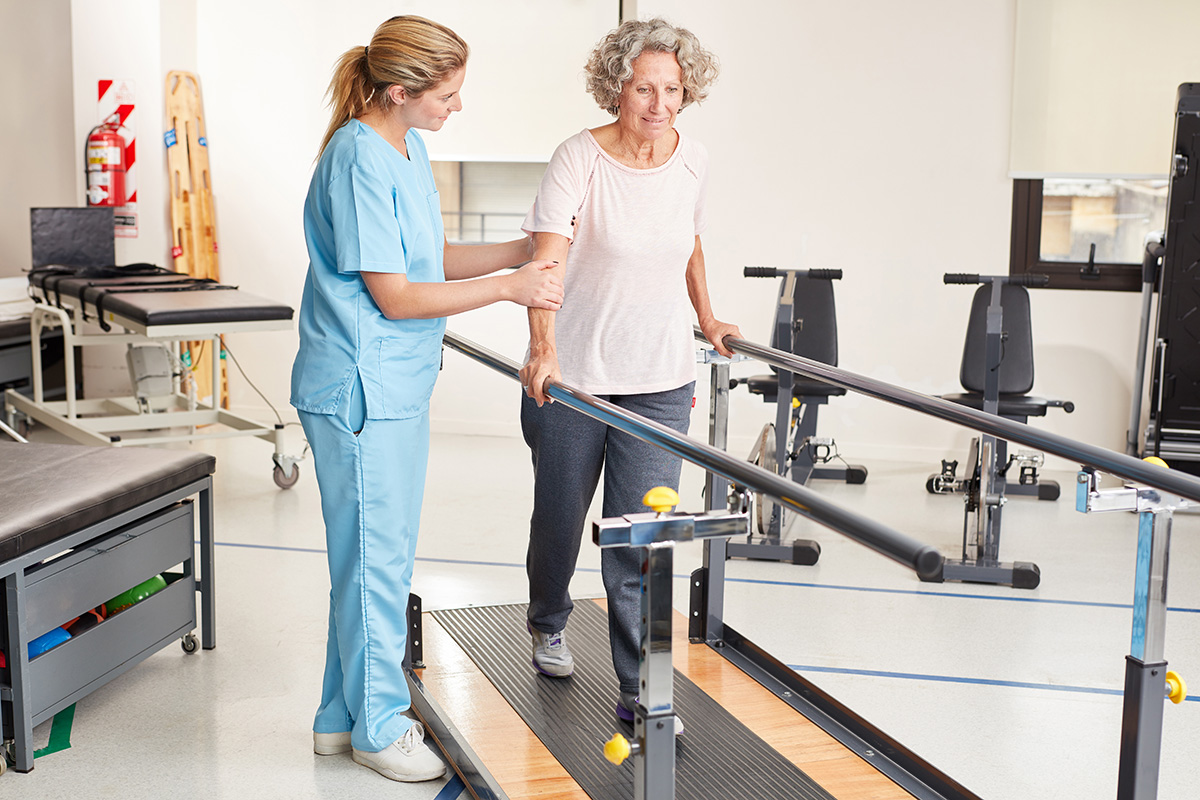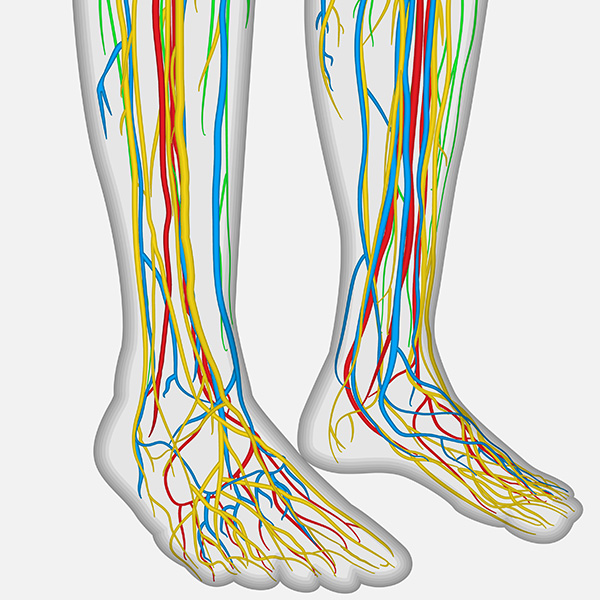Country Summaries Peripheral Patients? A Review of Peripheral Arterial Disease

Lower extremity peripheral avenue disease (PAD) is the third leading crusade of atherosclerotic vascular morbidity after coronary heart disease and stroke.one It is estimated that over 200 million people worldwidetwo and eight.5 million Americans over the historic period of 40three have PAD.
Intermittent claudication from PAD is known to affect approximately iv.5% of the general population at or over the historic period of 404 and information technology is independently associated with an increased risk of all-crusade and cardiovascular mortality5, half-dozen and marked reductions in quality of life.7, 8
Unfortunately, few constructive treatments exist for intermittent claudication.nine Cilostazol is the only effective medical therapy to improve symptoms simply is non widely utilized.10 Pentoxifylline is the only other medication that has U.South. Food and Drug Administration approval for the handling of PAD-related walking harm,11 but is no longer guideline-recommended due to lack of information supporting its efficacy.10
Supervised exercise therapy (Fix) is an constructive intervention to reduce lower extremity symptoms in patients with intermittent claudication from PAD. Due to data from several trials, including ones with long-term follow-upwards,12-fourteen consensus guidelines recommend Ready to improve functional status and quality of life, and to reduce leg symptoms.10

The guidelines also recommend Set prior to consideration of revascularization, as well as a key part of combination therapy in patients who undergo revascularization for refractory sytmptoms.10
The Endovascular Revascularization and Supervised Exercise (ERASE) report institute that later on ane year of follow-upwardly, combination therapy with endovascular revascularization followed by SET resulted in significantly greater improvement in walking distances and quality of life scores compared with SET only in patients with PAD and stable claudication for at least three months.15
Until 2017, the lack of reimbursement for this therapy greatly express access and utilization.16 However, in 2017, the Centers for Medicare and Medicaid Services (CMS) "determined that the bear witness [was] sufficient to comprehend SET for beneficiaries with intermittent claudication for the treatment of symptomatic PAD" (CPT lawmaking: 93668). Up to 36 sessions are covered over a 12-week period if all the components listed in Tabular array ane are met.
Table 1: CMS Requirements For Supervised Practice Therapy Programme
| Session Requirements | Sessions lasting 30-60 minutes comprising therapeutic exercise-grooming program for peripheral artery disease in patients with claudication |
| Setting Requirements | Conducted in a infirmary outpatient setting or a physician's part |
| Delivery and Supervision Requirements | Delivered by qualified auxiliary personnel necessary to ensure benefits exceed harms, and who are trained in exercise therapy for peripheral artery disease |
| Under the direct supervision of a physician, physician assistant, or nurse practitioner/clinical nurse specialist who must be trained in both basic and advanced life back up techniques |
In improver, beneficiaries must have a face-to-face visit with the physician responsible for PAD treatment to obtain the referral to Set up, and the beneficiary must receive information regarding cardiovascular illness and PAD risk factor reduction at this visit.

Graded treadmill-based exercise prescriptions are the foundation of Gear up. After a five-minute warm-up period, participants are asked to walk on the treadmill using provider- and patient-centered protocols until they have mild to moderate pain (3-4 of 5 on the claudication scale17, 18).
They are then asked to stop, sit downwards and residue until the hurting has completed resolved. Then they resume walking. The goal is to reach an practise session of 50 minutes in duration (including remainder periods), which allows for 5-minute warm-up and cool-down periods to bring the full session duration to sixty minutes.
Progression of the intensity of the practice prescription typically occurs betwixt sessions, not during a session. Commonly utilized graded protocols in Fix Programs are listed in Table 2.19-22
Table two: Standardized Graded Treadmill Practise Protocols For Supervised Exercise Therapy
| Gardner-Skinner Protocol nineteen | Hiatt Protocol 20 | Bronas/Treat-Jacobson Protocol 21 |
|
|
|
*Patients unable to showtime walking at 2 miles per hour can start at 0.5 miles per hour and increase speed by 0.v miles per hour every 2 minutes until a speed of 2 miles per hour is reached.
In addition to graded exercise examination-based metrics, functional evaluation tin be washed at intake and exit sessions with a six-minute walk test.23, 24 Symptom and quality of life assessments tin be done via affliction-specific questionnaires, such as the Walking Damage Questionnaire (WIQ)25 and the Peripheral Artery Questionnaire (PAQ),26 and other validated metrics.
In improver to improving admission to guideline-recommended care for patients with PAD and providing patient-centered care, the establishment and growth of a Set Program provide opportunities to build on intra- and inter-institutional collaboration between cardiovascular medicine, interventional cardiology and vascular surgery programs.
Benefits include direct revenue generation through a service offering, referrals to a heart'due south vascular lab, vascular imaging center, cardiovascular medicine and vascular surgery clinics, and interventional and surgical programs, and opportunities for enquiry.

Importantly, many centers already take the infrastructure needed to build a Prepare Program via their existing cardiac rehabilitation and/or physical therapy programs.22, 27
After rolling out the Program on a small calibration, it can abound quickly with referrals and charges that volition permit for resources allocation requests. With increases in enrollment, enquiry programs and quality improvement initiatives tin can be congenital within SET Programs.
An important gimmicky consideration due to the COVID-19 pandemic is that home-based exercise regimens for intermittent claudication from PAD, while less effective than Set, may be reasonable options.
Many cardiac rehabilitation and concrete therapy centers remain closed or have drastically express the number of patients they serve. Studies accept shown that home-based programs can improve walking endurance and physical activity in patients with PAD.28
In summary, Set up is a data-supported and guideline-recommend handling for patients with intermittent claudication from PAD. It is our responsibility as a cardiovascular community to improve access to this important handling, especially at present that information technology is a reimbursed service past CMS for Medicare beneficiaries, and by many private insurers.
Join the ACC in Recognizing PAD Sensation Month

All twelvemonth long, visit ACC.org to access the tools, resources and education yous need to care for your patients with PAD. Don't miss the Peripheral Vascular Affliction Member Section and the Vascular Medicine Clinical Topic Collection.
Click hither for CardioSmart'due south PAD Condition Center for tools to assistance patients better empathize their condition including a downloadable infographic, resource to find support, questions to ask their physicians, and more.
Make sure to join the conversation on Twitter using #PADawareness and tagging @ACCinTouch.
References
- Fowkes FG, Rudan D, Rudan I, et al. Comparison of global estimates of prevalence and chance factors for peripheral artery disease in 2000 and 2010: a systematic review and assay. Lancet 2013;382:1329-40.
- Criqui MH, Aboyans 5. Epidemiology of peripheral avenue illness. Circ Res 116:1509-26.
- Mozaffarian D, Benjamin EJ, Go Every bit, et al. Heart disease and stroke statistics-2016 update: A report from the American Heart Association. Circulation 2016;133:e38-360.
- Fakhry F, Fokkenrood HJ, Spronk S, et al. Endovascular revascularisation versus conservative management for intermittent claudication. Cochrane Database Syst Rev 03 2018;iii:CD010512.
- Golomb BA, Dang TT, Criqui MH. Peripheral arterial disease: morbidity and mortality implications. Circulation 2006;114:688-99.
- Smith GD, Shipley MJ, Rose G. Intermittent claudication, heart disease risk factors, and mortality.The Whitehall Written report. Apportionment 1990;82:1925-31.
- Khaira HS, Hanger R, Shearman CP. Quality of life in patients with intermittent claudication. Eur J Vasc Endovasc Surg 1996;11:65-nine.
- Spronk Southward, White JV, Bosch JL, Hunink MG. Touch on of claudication and its treatment on quality of life. Semin Vasc Surg 2007;twenty:3-nine.
- Berger JS, Hiatt WR. Medical therapy in peripheral artery disease. Circulation 2012;126:491-500.
- Gerhard-Herman MD, Gornik HL, Barrett C, et al. 2016 AHA/ACC guideline on the direction of patients with lower extremity peripheral artery disease: Executive Summary: A Report of the American College of Cardiology/American Heart Association Task Force on Clinical Practice Guidelines. J Am Coll Cardiol 2017;69:1465-1508.
- McDermott MM. Reducing disability in peripheral artery disease: The role of revascularization and supervised exercise therapy. JACC Cardiovasc Interv 2019;12:1137-9.
- Fakhry F, Rouwet EV, den Hoed PT, et al. Long-term clinical effectiveness of supervised exercise therapy versus endovascular revascularization for intermittent claudication from a randomized clinical trial. Br J Surg 2013;100:1164-71.
- Murphy TP, Cutlip DE, Regensteiner JG, et al. Supervised exercise versus primary stenting for claudication resulting from aortoiliac peripheral artery affliction: six-month outcomes from the claudication: exercise versus endoluminal revascularization (CLEVER) study. Apportionment 2012;125:130-9.
- Murphy TP, Cutlip DE, Regensteiner JG, et al. Supervised practise, stent revascularization, or medical therapy for claudication due to aortoiliac peripheral avenue disease: the CLEVER study. J Am Coll Cardiol 2015;65:999-1009.
- Fakhry F, Spronk Southward, van der Laan L, et al. Endovascular revascularization and supervised do for peripheral artery disease and intermittent claudication: A randomized clinical trial. JAMA 2015;314:1936-44.
- Harwood AE, Smith GE, Cayton T, et al. A systematic review of the uptake and adherence rates to supervised practise programs in patients with intermittent claudication. Ann Vasc Surg 2016;34:280-9.
- Weinberg Md, Lau JF, Rosenfield K, Olin JW. Peripheral avenue disease. Part ii: medical and endovascular treatment. Nat Rev Cardiol 2011;viii:429-41.
- Olin JW, White CJ, Armstrong EJ, et al. Peripheral artery disease: Evolving role of exercise, medical therapy, and endovascular options. J Am Coll Cardiol 2016;67:1338-57.
- Gardner A, Skinner J, Cantwell B, Smith Fifty. Progressive vs single-stage treadmill tests for evaluation of claudication. Med Sci Sports Exerc 1991:402-8.
- Hiatt WR, Regensteiner JG, Hargarten ME, et al. Benefit of exercise conditioning for patients with peripheral arterial illness. Apportionment 1990;81:602-9.
- Care for-Jacobson D, Bronas UG, Leon Equally. Efficacy of arm-ergometry versus treadmill practise training to improve walking distance in patients with claudication. Vasc Med 2009;fourteen:203-13.
- Treat-Jacobson D, McDermott MM, Beckman JA, et al. Implementation of supervised exercise therapy for patients with symptomatic peripheral artery disease: A science advisory from the American Heart Association. Circulation 2019;140:e700-e710.
- Guyatt GH, Sullivan MJ, Thompson PJ, et al. The vi-minute walk: a new measure of exercise capacity in patients with chronic eye failure. Tin can Med Assoc J 1985;132:919-23.
- McDermott MM, Guralnik JM, Criqui MH, et al. Six-minute walk is a better outcome measure out than treadmill walking tests in therapeutic trials of patients with peripheral artery disease. Circulation 2014;130:61-eight.
- Regensteiner JG, Steiner JF, Hiatt WR. Exercise training improves functional status in patients with peripheral arterial illness. J Vasc Surg 1996;23:104-fifteen.
- Spertus J, Jones P, Poler S, Rocha-Singh Yard. The peripheral artery questionnaire: a new disease-specific wellness status measure for patients with peripheral arterial disease. Am Center J 2004;147:301-viii.
- Salisbury DL, Whipple MO, Burt M, et al. Experience implementing supervised practice therapy for peripheral artery disease. J Clin Exerc Physiolr 2019;eight:1-12.
- McDermott MM, Liu One thousand, Guralnik JM, et al. Habitation-based walking practice intervention in peripheral artery illness: a randomized clinical trial. JAMA 2013;310:57-65.
Keywords: ACC Publications, Cardiology Mag, Intermittent Claudication, Peripheral Arterial Disease, Exercise Test, Walking, Cardiac Rehabilitation, Pentoxifylline, COVID-nineteen, Quality of Life, Gamble Factors, Centers for Medicare and Medicaid Services, U.S., Electric current Procedural Terminology, Medicare, Nurse Clinicians
< Back to Listings
Source: https://www.acc.org/latest-in-cardiology/articles/2020/09/01/01/42/supervised-exercise-therapy-for-patients-with-peripheral-artery-disease-supervised-exercise-therapy-for-patients-with-peripheral-artery-disease


0 Response to "Country Summaries Peripheral Patients? A Review of Peripheral Arterial Disease"
Post a Comment